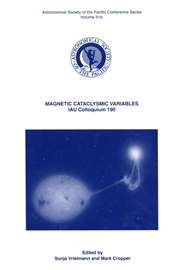Article contents
Disks formed by Rotation Induced Bi-stability
Published online by Cambridge University Press: 12 April 2016
Abstract
We discuss the evidence for the existence of bi-stable stellar winds of early type stars, both theoretically and observationally. The ratio between the terminal wind velocity and the escape velocity drops steeply from about 2.6 for stars with T eff > 21 000 K to about 1.3 at T eff < 21 000 K. This is the bi-stability jump, which is due to a change in the ionization of the wind and in the wind driving lines. The mass loss rate increases across the jump by about a factor 2 to 5 from the hotter to the cooler stars. The mass flux from rapidly rotating stars can also show the bi-stability jump at some lattitude between the pole and the equator, with a slow high density wind in the equatorial region and a faster low density wind from the poles. This might explain the disks of rapidly rotating B[e] stars, formed by the Rotation Induced Bi-stability mechanism. We discuss the RIB mechanism and its properties. We also describe some future improvements of the model.
Information
- Type
- Section II Theory of Non-spherical Winds
- Information
- Copyright
- Copyright © Springer-Verlag 1999
- 3
- Cited by

